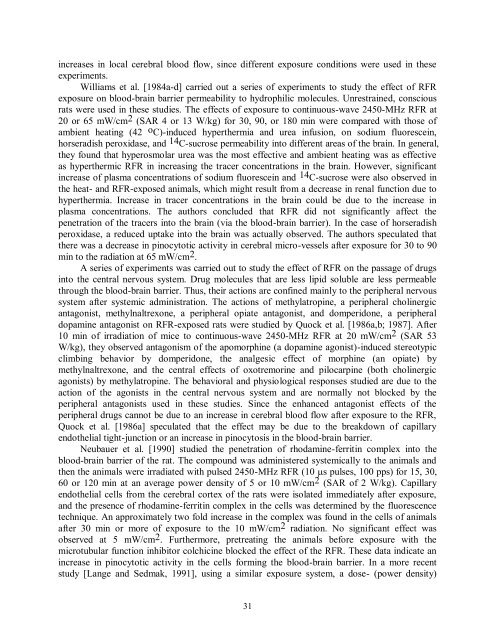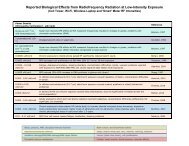Evidence for Effects on Neurology and Behavior - BioInitiative Report
Evidence for Effects on Neurology and Behavior - BioInitiative Report
Evidence for Effects on Neurology and Behavior - BioInitiative Report
You also want an ePaper? Increase the reach of your titles
YUMPU automatically turns print PDFs into web optimized ePapers that Google loves.
increases in local cerebral blood flow, since different exposure c<strong>on</strong>diti<strong>on</strong>s were used in these<br />
experiments.<br />
Williams et al. [1984a-d] carried out a series of experiments to study the effect of RFR<br />
exposure <strong>on</strong> blood-brain barrier permeability to hydrophilic molecules. Unrestrained, c<strong>on</strong>scious<br />
rats were used in these studies. The effects of exposure to c<strong>on</strong>tinuous-wave 2450-MHz RFR at<br />
20 or 65 mW/cm 2 (SAR 4 or 13 W/kg) <str<strong>on</strong>g>for</str<strong>on</strong>g> 30, 90, or 180 min were compared with those of<br />
ambient heating (42 o C)-induced hyperthermia <strong>and</strong> urea infusi<strong>on</strong>, <strong>on</strong> sodium fluorescein,<br />
horseradish peroxidase, <strong>and</strong> 14 C-sucrose permeability into different areas of the brain. In general,<br />
they found that hyperosmolar urea was the most effective <strong>and</strong> ambient heating was as effective<br />
as hyperthermic RFR in increasing the tracer c<strong>on</strong>centrati<strong>on</strong>s in the brain. However, significant<br />
increase of plasma c<strong>on</strong>centrati<strong>on</strong>s of sodium fluorescein <strong>and</strong> 14 C-sucrose were also observed in<br />
the heat- <strong>and</strong> RFR-exposed animals, which might result from a decrease in renal functi<strong>on</strong> due to<br />
hyperthermia. Increase in tracer c<strong>on</strong>centrati<strong>on</strong>s in the brain could be due to the increase in<br />
plasma c<strong>on</strong>centrati<strong>on</strong>s. The authors c<strong>on</strong>cluded that RFR did not significantly affect the<br />
penetrati<strong>on</strong> of the tracers into the brain (via the blood-brain barrier). In the case of horseradish<br />
peroxidase, a reduced uptake into the brain was actually observed. The authors speculated that<br />
there was a decrease in pinocytotic activity in cerebral micro-vessels after exposure <str<strong>on</strong>g>for</str<strong>on</strong>g> 30 to 90<br />
min to the radiati<strong>on</strong> at 65 mW/cm 2 .<br />
A series of experiments was carried out to study the effect of RFR <strong>on</strong> the passage of drugs<br />
into the central nervous system. Drug molecules that are less lipid soluble are less permeable<br />
through the blood-brain barrier. Thus, their acti<strong>on</strong>s are c<strong>on</strong>fined mainly to the peripheral nervous<br />
system after systemic administrati<strong>on</strong>. The acti<strong>on</strong>s of methylatropine, a peripheral cholinergic<br />
antag<strong>on</strong>ist, methylnaltrex<strong>on</strong>e, a peripheral opiate antag<strong>on</strong>ist, <strong>and</strong> domperid<strong>on</strong>e, a peripheral<br />
dopamine antag<strong>on</strong>ist <strong>on</strong> RFR-exposed rats were studied by Quock et al. [1986a,b; 1987]. After<br />
10 min of irradiati<strong>on</strong> of mice to c<strong>on</strong>tinuous-wave 2450-MHz RFR at 20 mW/cm 2 (SAR 53<br />
W/kg), they observed antag<strong>on</strong>ism of the apomorphine (a dopamine ag<strong>on</strong>ist)-induced stereotypic<br />
climbing behavior by domperid<strong>on</strong>e, the analgesic effect of morphine (an opiate) by<br />
methylnaltrex<strong>on</strong>e, <strong>and</strong> the central effects of oxotremorine <strong>and</strong> pilocarpine (both cholinergic<br />
ag<strong>on</strong>ists) by methylatropine. The behavioral <strong>and</strong> physiological resp<strong>on</strong>ses studied are due to the<br />
acti<strong>on</strong> of the ag<strong>on</strong>ists in the central nervous system <strong>and</strong> are normally not blocked by the<br />
peripheral antag<strong>on</strong>ists used in these studies. Since the enhanced antag<strong>on</strong>ist effects of the<br />
peripheral drugs cannot be due to an increase in cerebral blood flow after exposure to the RFR,<br />
Quock et al. [1986a] speculated that the effect may be due to the breakdown of capillary<br />
endothelial tight-juncti<strong>on</strong> or an increase in pinocytosis in the blood-brain barrier.<br />
Neubauer et al. [1990] studied the penetrati<strong>on</strong> of rhodamine-ferritin complex into the<br />
blood-brain barrier of the rat. The compound was administered systemically to the animals <strong>and</strong><br />
then the animals were irradiated with pulsed 2450-MHz RFR (10 s pulses, 100 pps) <str<strong>on</strong>g>for</str<strong>on</strong>g> 15, 30,<br />
60 or 120 min at an average power density of 5 or 10 mW/cm 2 (SAR of 2 W/kg). Capillary<br />
endothelial cells from the cerebral cortex of the rats were isolated immediately after exposure,<br />
<strong>and</strong> the presence of rhodamine-ferritin complex in the cells was determined by the fluorescence<br />
technique. An approximately two fold increase in the complex was found in the cells of animals<br />
after 30 min or more of exposure to the 10 mW/cm 2 radiati<strong>on</strong>. No significant effect was<br />
observed at 5 mW/cm 2 . Furthermore, pretreating the animals be<str<strong>on</strong>g>for</str<strong>on</strong>g>e exposure with the<br />
microtubular functi<strong>on</strong> inhibitor colchicine blocked the effect of the RFR. These data indicate an<br />
increase in pinocytotic activity in the cells <str<strong>on</strong>g>for</str<strong>on</strong>g>ming the blood-brain barrier. In a more recent<br />
study [Lange <strong>and</strong> Sedmak, 1991], using a similar exposure system, a dose- (power density)<br />
31



